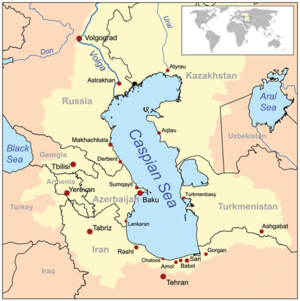Derbent
| Author: Laxman Burdak, IFS (R) |

Derbent, formerly romanized as Derbend,[1] is a city in Dagestan, Russia. Derbent claims to be the oldest city in Russia.
Variants
- Derbent Pass
- Darband (Persian: دربند, lit. 'Door/opening in a Barrier', from dar “door/gate” + band “barrier/dam”, lit., “gate in the barrier”[2])
- Derbend
- Russian: Дербе́нт;
- Lezgian: Кьвевар, Цал;
- Azerbaijani: Дәрбәнд,
- romanized: Dərbənd;
- Avar: Дербенд;
- Persian: دربند
- Bāb al-Abwāb (In Arabic texts) (Arabic: بَاب ٱلْأَبْوَاب, lit. 'Gate of all Gates'),[3]
- al-Bāb (Arabic: ٱلْبَاب, lit. 'The Gate')
- Bāb al-Hadid (Arabic: بَاب ٱلْحَدِيد, lit. 'Gate of Iron').[4]
- Demirkapi - "Iron Gate" was used by Turkic peoples, in the form "Demirkapi".[5]
Location
It is located on the Caspian Sea. It is the southernmost city in Russia, and it is the second-most important city of Dagestan. Derbent occupies the narrow gateway between the Caspian Sea and the Caucasus Mountains connecting the Eurasian Steppe to the north and the Iranian Plateau to the south.
Jat clans
Etymology
Derbent is derived from Persian "Darband" (Persian: دربند, lit. 'Door/opening in a Barrier', from dar “door/gate” + band “barrier/dam”, lit., “gate in the barrier”[6]), referring to the eastern-most pass in the high Caucasus Mountains (whence the putative "barrier/dam") on the beaches of the Caspian Sea. (The other pass, the Darial Pass, is in Central Caucasus Mountains, and likewise carries a Persian name, standing for "the Alan Pass/gate" – with the Alans being the modern Iranic Ossetians.)
It is often identified with the Gates of Alexander, a legendary barrier supposedly built by Alexander the Great in the Caucasus. The Persian name for the city came into use at the end of the 5th or the beginning of the 6th century AD, when the city was re-established by Kavadh I of the Sassanid dynasty of Persia, but Derbent was probably already in the Sasanian sphere of influence as a result of the victory over the Parthians and the conquest of Caucasian Albania by Shapur I, the second shah of the Sassanid Persians.[7] The geographical treatise Šahrestānīhā ī Ērānšahr written in Middle Persian mentions the old name of the fortress – Wērōy-pahr (The Gruzinian Guard):
- šahrestan [ī] kūmīs [ī] panj-burg až-i dahāg pad šabestān kard. māniš [ī] *pārsīgān ānōh būd. padxwadayīh [ī] yazdgird ī šabuhrān kard andar tāzišn ī čōl wērōy-pahr [ī] an ālag. (The city of Kūmīs of five towers Aži Dahag made it his own harem. The abode of the Parthians was there. In the reign of Yazdgird, the son of Šabuhr made it during the invasion of the Čōl, at the boundary of the Gruzinian Guard.).[8]
In Arabic texts the city was known as "Bāb al-Abwāb" (Arabic: بَاب ٱلْأَبْوَاب, lit. 'Gate of all Gates'),[10] simply as "al-Bāb" (Arabic: ٱلْبَاب, lit. 'The Gate') or as "Bāb al-Hadid" (Arabic: بَاب ٱلْحَدِيد, lit. 'Gate of Iron').[11] A similar name meaning "Iron Gate" was used by Turkic peoples, in the form "Demirkapi".[12]
History
Derbent claims to be the oldest city in Russia, with historical documentation dating to the 8th century BC, making it one of the oldest continuously inhabited cities in the world.[13] Due to its strategic location, over the course of history, the city changed ownership many times, particularly among the Persian, Arab, Mongol, Timurid, and Shirvan kingdoms.
Derbent's location on a narrow, three-kilometer strip of land in the North Caucasus between the Caspian Sea and the Caucasus mountains is strategic in the entire Caucasus region. Historically, this position allowed the rulers of Derbent to control land traffic between the Eurasian Steppe and the Middle East. The only other practicable crossing of the Caucasus ridge was over the Darial Gorge.
In the 19th century, the city passed from Persian into Russian hands by the Treaty of Gulistan of 1813.[14]
References
- ↑ Baynes, T. S., ed. (1878). "Derbend" . Encyclopædia Britannica. Vol. 7 (9th ed.). New York: Charles Scribner's Sons. p. 105.
- ↑ Zonn, Igor S.; Kosarev, Aleksey N.; Glantz, Michael; Kostianoy, Andrey G. (2010). The Caspian Sea Encyclopedia. Springer. p. 160.
- ↑ McFarquhar, Neil (February 17, 2016). "Derbent as Russia's Oldest City? Think Again, Moscow Says". The New York Times.
- ↑ Chenciner, Robert (October 12, 2012). Daghestan: Tradition and Survival. Routledge. ISBN 9781136107146.
- ↑ McFarquhar, Neil (February 17, 2016). "Derbent as Russia's Oldest City? Think Again, Moscow Says". The New York Times.
- ↑ Zonn, Igor S.; Kosarev, Aleksey N.; Glantz, Michael; Kostianoy, Andrey G. (2010). The Caspian Sea Encyclopedia. Springer. p. 160.
- ↑ Darband, Encyclopaedia Iranica
- ↑ Daryaee, Touraj (2002). Šahrestānīhā Ī Ērānšahr: A Middle Persian Text on Late Antique Geography, Epic, and History. Costa Mesa, California 92628 U.S.A.: Mazda Publishers, Inc. pp. 14, 18. ISBN 1-56859-143-8.
- ↑ Daryaee, Touraj (2002). Šahrestānīhā Ī Ērānšahr: A Middle Persian Text on Late Antique Geography, Epic, and History. Costa Mesa, California 92628 U.S.A.: Mazda Publishers, Inc. p. 40. ISBN 1-56859-143-8.
- ↑ McFarquhar, Neil (February 17, 2016). "Derbent as Russia's Oldest City? Think Again, Moscow Says". The New York Times.
- ↑ Chenciner, Robert (October 12, 2012). Daghestan: Tradition and Survival. Routledge. ISBN 9781136107146.
- ↑ McFarquhar, Neil (February 17, 2016). "Derbent as Russia's Oldest City? Think Again, Moscow Says". The New York Times.
- ↑ Derbent - Russia’s oldest city: 5,000 and counting Archived May 15, 2012, at the Wayback Machine
- ↑ Timothy C. Dowling Russia at War: From the Mongol Conquest to Afghanistan, Chechnya, and Beyond p 728 ABC-CLIO, 2 dec. 2014 ISBN 1598849484
Back to Central Asia